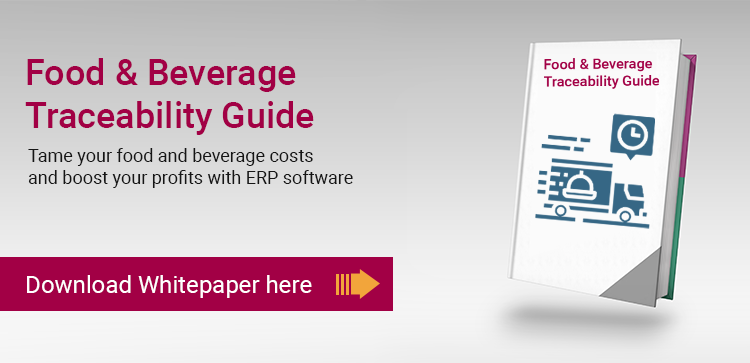Summary: The COVID-19 pandemic impacted the Food & Beverage industry supply chains across the globe. Incessant lockdowns caused customer demands to fluctuate. As a result, consumers displayed higher interest levels for specific goods while demand for several others waned. This sudden rise and fall forced supply chain manufacturers to modify their inventory management practices and increase their supply.

The food production industry is unique as most stock is perishable, requiring companies to ensure consumer safety and timely delivery of products. Moreover, this industry is highly regulated and must comply with government-mandated health standards.
Therefore, F&B manufacturers need excellent inventory management systems that monitor the process of manufacturing raw materials into finished products, the movement of goods to warehouses, and finally to the point-of-sale (POS). The primary purpose is to facilitate the buying and selling of products smoothly.
Enhancing inventory management requires efficient systems for monitoring and controlling warehouse operations remotely. It also includes efficiently managing the physical stocks stored inside the inventory.
This article will shed light on six inventory management tips that will enable F&B manufacturers to improve inventory management.
1. Perform a 360-degree evaluation of your current inventory management practices.
Remember that effective inventory management calls for purpose-driven motives. Therefore, before making improvements, take a look at your current business practices and learn about each link in your supply chain. This process will help you identify the inherent challenges in the system and brainstorm ways on how to improve them.
There are seven waste areas in the food production industry that you should look for to improve your inventory processes.
- Use modern tools and demand planning techniques to support just-in-time production and avoid buying too much inventory.
- Reduce overproduction by enhancing controls and visibility to align purchasing, production, and logistics.
- Ensure your machinery is working efficiently and productively by providing data.
- Deal with transport challenges by implementing new & improved logistic solutions. You don’t need to move goods unnecessarily from one place to another.
- Implement appropriate controls to eliminate defects, identify where deviation occurs, and stop them at the source.
- Provide relevant access mechanisms to the staff that will enable them to streamline approvals and make decisions automatically.
- Focus on activities that add value to the company, such as creating a Bill of Materials (BOM). Instead of doing manual and repetitive jobs like entering data from one sheet to another.
2. Understand the role of customer data in inventory management.
Big data allows F&B manufacturers to make accurate predictions about consumer choices. For reducing operational and manufacturing costs, you must invest in activities that generate value for consumers. Big data allows you to base your decisions on critical factors like geographic, demographic, psychographic, and behavioral parameters. These factors help determine which products are most likely to sell in the market and thus contribute to the company’s treasury. As a result, organizations can brainstorm upsell and cross-sell opportunities and avoid stocking unnecessary items.
You can also use data to track which products you are stocking and recognize patterns and trends (due to seasonal or other external factors) that impact the product flow. For example, identify the periods when customers are ordering high quantities of your products and when they aren’t showing as much interest. In short, inventory management software allows F&B manufacturers to maintain the right inventory balance during dry spells and mad rushes.
Big data allows inventory management systems to identify and red flag problems in the supply chain that you might have never known about. By gathering crucial data from the Internet of Things (IoT) tools and sensors, you can spot machines not delivering maximum performance and identify sensitive areas that may be susceptible to hacks.
3. Optimizing stock replenishment is essential for the food production industry.
An automatic inventory replenishment system ensures that you always have a desired stock level in the inventory. It ensures that the production process runs smoothly, even during busy days. F&B manufacturers rely on just-in-time manufacturing strategies, where new stock is ordered each day based on the sales demand. This way, eating outlets and supermarkets can keep only the required inventory and maximize their food shelf life.
Do you have a sound just-in-time strategy in place? If not, you should formulate a policy that constantly replenishes stocks. This way, if the stock falls below a certain level, the inventory will be automatically replenished.
Earlier, companies had manual processes in place for acquiring raw materials. But today, technology has made it possible to stock inventory automatically. In addition, it examines trends and provides a complete picture of which products are more likely to sell. Thus, the staff can maintain large stocks of products with high selling potential.
4. Inventory management software ensures faster product recalls.
Recalling food & beverage items may cause a lot of trouble if not handled properly. It may tarnish your brand image as consumers aren’t shy of putting negative feedback on social media and e-Commerce portals. Therefore, you need to act quickly and efficiently to ensure menial damage to the consumer and your brand in such circumstances.
Inventory management systems allow F&B manufacturers to quickly identify where the problem lies, provide market reassurance, and eliminate product recall costs. In addition, the food production industry benefits immensely from inventory management systems as they provide a central repository allowing relevant stakeholders to access critical data immediately. This data can be used to track each link in the supply chain, examine the production process, and provide instant replies to customer queries.
The safest bet to protect your brand image is to communicate with authenticity that you have the resources, workforce, and the right software solutions to control the situation.
<<<Also Read: The secret sauce for effective food traceability – Food & Beverage ERP>>>
5. Eliminate waste in the food & beverage industry.
Today, customers have become very conscious of the surroundings they live in. The main reasons behind this change are:
- The rise in education levels.
- News about the negative impacts of environmental degradation.
- Government-supported ecological awareness.
Therefore, consumers expect F&B manufacturers to implement processes that don’t harm the environment.
It means companies in the food production industry need to implement technologies that eliminate perishables that go to waste and reduce excess inventory. Therefore, while selecting an inventory management software, ensure that it helps promote a green agenda, increase production efficiency, minimize operational costs, and enhance the quality of operations.
Further, examine ways in which surplus products could be reused effectively. For example, you could donate excessive food to charitable organizations for free. Or you can sell products, which supermarkets turn away, at discounts.
6. F&B manufacturers should check stocks regularly.
An essential part of inventory management is to know how many items are available in the stock. Remember that knowing what came in and went out of the inventory will not provide a 360-degree view because F&B products can get stolen, lost, or damaged once they enter the warehouse. General observation shows that lost items are never reported until the designated person takes notice. The only solution to this challenge is regularly reviewing stocks in the warehouse by using an inventory management solution.
STAY UPDATED
Subscribe To Our Newsletter
At Sage Software Solutions (P) Ltd., we are home to world-class ERP software and CRM software that will solidify your business tech support fundamentals and enable you to build a customer-centric organization. You can also write to us at sales@sagesoftware.co.in.
Disclaimer: All the information, views, and opinions expressed in this blog are those of the authors and their respective web sources and in no way reflect the principles, views, or objectives of Sage Software Solutions (P) Ltd.








